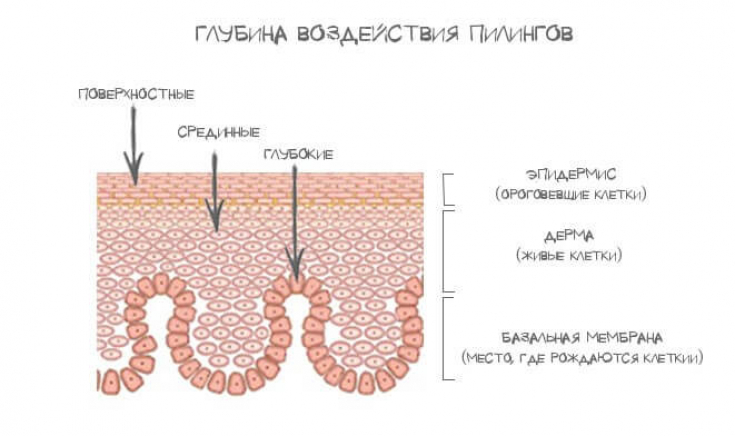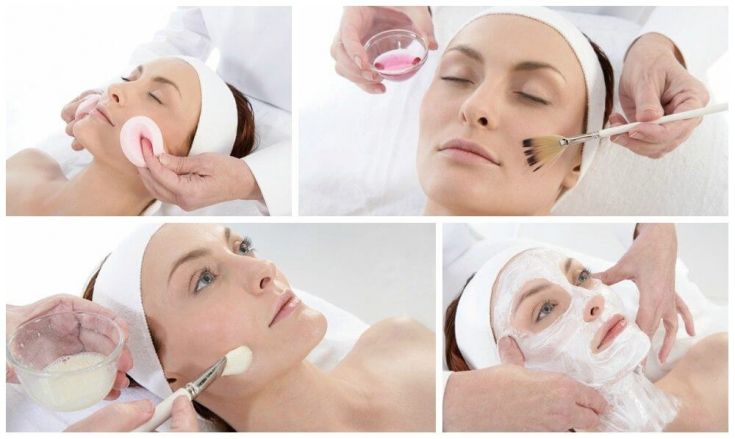Glycolic Acid – it is a natural and very effective way of exfoliating and deep cleansing.
When applied topically, this natural acid helps to remove dead skin cells, which can help with many common skin problems from acne to wrinkles.
Glycolic acid works by breaking the bonds of old, unwanted skin cells that can clog pores and make skin look dull.
After using glycolic acid, many people report a revitalized, radiant look.
On estet-portal.com read about the main effects of glycolic acid and Glycolic Peeling Rules.
- What is glycolic acid
- Indications for the use of glycolic acid
- How to Use Glycolic Acid Properly
- Glycol peeling: features carried outia
What is glycolic acid
Both alpha hydroxy acids (AHAs) and beta hydroxy acids (BHA) are widely used in skin care products today.
The beta hydroxy acid most commonly used in cosmetics is salicylic acid.
Alpha hydroxy acids used in cosmetics include glycolic, malic and lactic acids.
What can a chemical peel do in skincare
Glycolic Acid – it is a colorless, odorless alpha-hydroxy acid that is usually obtained from sugar cane or created syntheticallyand.

Glycolic acid easily absorbs and retains moisture, and its simple and small molecules easily and quickly penetrate the skin.
Indications for the use of glycolic acid
In general, glycolic acid acts as a skin exfoliator that helps to remove dead skin cells as well as excess sebum.
As an active ingredient in skin care, glycolic acid can speed up the skin renewal process, improve texture as well as the appearance of the skin.
Dermatologists and estheticians may prescribe glycolic acid for the following skin problems:
- acne;
- comedones;
- large pores;
- hyperpigmentation;
- pigment spots;
- signs of aging, including fine lines and wrinkles;
- follicular keratosis;
- hyperkeratosis;
- psoriasis.
In addition to improving skin condition for all these problems, glycolic acid can also increase collagen productionbecause it stimulates fibroblasts in the dermis.
This will make your skin look smoother and firmerth.
How does the activity of phagocytes change in acne
How to use glycolic acid correctly
As with other exfoliating products, start by applying a small amount of the product to a limited area of skin to see how the skin reacts to the glycolic acid product.
If the patient has sensitive skin, it is even more important to be careful.
A cleanser containing glycolic acid can be a good first exposure of a patient's skin to glycolic acid.
If the client tolerates the use of such a product, you can move on to other products thatth have glycolic acid.

- Isn't it better to use a higher percentage of glycolic acid?
In general, higher concentrations of glycolic acid produce a faster and more pronounced effect, but it also increases skin sensitivity. This is why glycol peeling should not be done too often (for example, once a monthyz).
Products with glycolic acid are generally recommended for people with normal, oily or combination skin. If the patient has dry or sensitive skin, it is better to use more gentle peels and products with a less aggressive composition.
- What are the side effects of glycolic acid?
Glycolic acid may increase the sensitivity of the patient's skin to the sun.
It is very important to remind the client to apply sunscreen after using any type of AHA to avoid sunburn.
It is often recommended to use products containing glycolic acid only butch.
Read the most interesting articles in Telegram!
Glycolic peeling: features of the procedure
Glycolic peeling, depending on the concentration of glycolic acid, can be superficial (15-40%), medium (50-60%) and deep (more than 70%).
Superficial is used to improve facial tone and treat acne.
Medium to fight pigmentation and fine lines, and deep to eliminate deep wrinkles.
Two weeks prior to peeling, the patient begins preparation for the procedure by applying a 5% solution of glycolic acid at bedtime for the first 5 days, and then 2 times a day. It is obligatory to carry out an allergy test before peeling.

Glycolic peel steps:
- Skin Cleansing;
- Applying the exfoliant to the skin with a brush;
- Removal of peeling from the face (the composition cannot be washed off with water, it is necessary to use a neutralizer, and only then remove the remaining gel with saline);
- Skin-soothing mask.
In general, the procedure lasts 30-40 minutes.
Rational use of glycolic acid, both in skin care products and in the form of glycolic peels, can improve the condition of the skin, and make the patient more beautiful and happier.
Acid Peeling: The Anatomy of a Chemical Peel







Add a comment